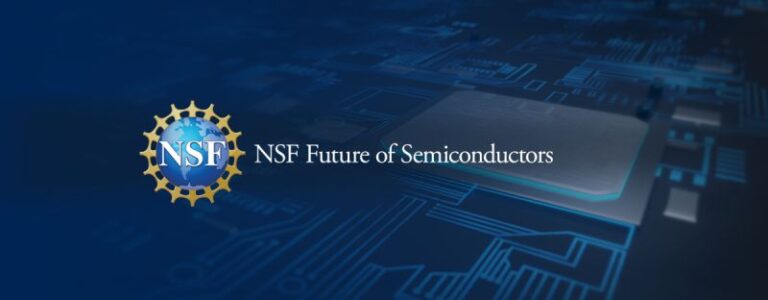Today, the National Science Foundation, in partnership with Ericsson, Intel Corporation, Micron Technology, and Samsung, announced a $42.4 million grant for the Future of Semiconductors (NSF FuSe2) competition. This investment will spur groundbreaking research and education across a range of semiconductor technologies, strengthening U.S. leadership in semiconductor research and innovation and solving key challenges in this critical field, including emerging computing tasks and applications, energy efficiency, performance, manufacturing, and supply chain.
NSF FuSe2 grants fund semiconductor research to advance technology and strengthen the U.S. semiconductor industry, supporting the broader goals of the CHIPS and Science Act of 2022 to ensure long-term leadership in the microelectronics sector and growth in local economies across the country. As demand for advanced computing capabilities grows, particularly in the areas of artificial intelligence and machine learning, the need for more efficient, scalable and reliable semiconductor technology becomes increasingly critical. Awarded projects explore new approaches to overcome existing limitations in semiconductor design and manufacturing, ensuring the United States remains at the forefront of global technological advancement.
This marks the next step for the FuSe program: Nearly one year ago today, NSF launched its first FuSe program, awarding $45.6 million to 24 research and education projects funded by the Biden Administration’s CHIPS and Science Act of 2022.
“Innovation in semiconductor research is critical to the future of our nation’s global competitiveness in modern electronics, computing, and supply chains,” said NSF Director Sethuraman Panchanathan. “These investments not only support the future of semiconductors as a driver of our economy, but also support our national security. Therefore, we must realize the full potential of emerging technologies, unlock new opportunities, and develop a skilled workforce that is ready to take on grand global challenges.”
The broad impact of these awards includes:
Advanced computing technologies. These projects aim to revolutionize computing by developing cutting-edge technologies such as ultra-thin oxide semiconductors, new chip designs, and advanced algorithms. By improving the performance of AI workloads and developing energy-efficient solutions for edge devices, these innovations promise to democratize access to advanced computing and improve efficiency in a wide range of applications, from wearable health devices to large-scale data centers. Improving energy efficiency and environmental impact. These projects improve energy efficiency within computing systems, including hardware for deep neural networks, vertical power delivery systems, and high-density 3D integrated circuits. These efforts can significantly reduce power consumption and cooling requirements to meet the growing energy demands of modern data centers and contribute to environmental sustainability. Advanced functionality and high-performance electronics. These projects aim to accelerate the adoption of advanced electronic, photonic, and hybrid devices and components for sensing, memory, and energy, enabling cutting-edge capabilities in semiconductor technology. Supporting holistic co-design of systems across devices, circuits, and algorithms by integrating new components and materials compatible with future technologies. Projects will focus on system-level strategies to achieve the most robust, compact, energy-efficient, and cost-effective solutions for how we process, store, communicate, and manipulate analog and digital information. Next-generation Materials and Devices: Projects will focus on developing new materials and devices that overcome existing limitations in data storage, processing, and quantum information processing, and provide breakthroughs in solving complex computational problems.
FuSe2 supports 23 cutting-edge research projects across 15 states and 20 institutions, including nine inaugural FuSe awardees, seven minority-serving institutions, and two NSF-established Competitive Research Accelerator Program jurisdictions.
Topic 1: Collaborative research in domain-specific computing
Bridging the Atomic Layer and Foundational Models: A Versatile Indium Oxide-Based Neural Computing Platform. Purdue University. Co-design of 3D Vertical Back-End-of-Line Ferroelectric Memory Capacitors and In-Memory Computing Circuits for Extremely Energy-Efficient Computing. University of Minnesota, Twin Cities. Domain-Specific Probabilistic Computing with Stochastic Antiferromagnetic Tunnel Junctions. Northwestern University. Edge Reinforcement Learning through Co-Design of Algorithms, Architectures, and Circuits. Texas A&M University. Efficient Edge Inference and Heterogeneous Integration in Health and Chemical Sensing Systems. University of Texas at Austin. Energy-Efficient Near-Memory CMOS+X Architecture for Hardware Acceleration of DNNs with Applications to NextG Wireless Systems. Arizona State University. Advancing RF-MIMO Radar Processing and Classification with the One-Shot PetaOps/W Analog Margin Propagation Computing Paradigm. University of Washington.
Topic 2: High functionality and performance through heterogeneous integration
Heterogeneous Integrated Arrays for Massively Scalable Sub-THz Communications and Sensing. Pennsylvania State University. Heterogeneous 3D Integration of Energy Efficient Electronics (H3E3) with Low Dimensional Device Layers. Stanford University. Heterogeneous In-Package Photonics with Reconfigurable Optical Switching for AI Clusters (HEROIC-AI). University of Michigan. Heterogeneous Integration of Wide Bandgap Microelectronics and Power Electronics for Efficient Powering AI Processors in Data Centers. Virginia Tech. High Resolution Imaging of Semiconductor Defects: Detection, Reliability, and Mitigation. Purdue University. Magnonic Combinatorial Memory and Logic Devices on a Silicon Platform. University of California, Riverside. Co-design of a Semiconductor-Based Quantum Architecture Platform for Scalable Quantum Information Processing. Massachusetts Institute of Technology.
Topic 3: New Materials for Energy Efficiency, Performance Improvement, and Sustainable Semiconductor-Based Systems
AI-Enhanced Materials Device Co-Design of Boron Arsenide as a Next-Generation Semiconductor. University of California, Santa Barbara. Co-Design of Sub-2nm Wide Bandgap Semiconductor Memristors for Neuromorphic Computing. University of Kansas. Co-Design of Indium-Based Sol-Gel Precursors for Extreme Ultraviolet Resists and Back-End-of-the-Line Oxide Nanoelectronics. University of Texas at Dallas. Energy-Efficient Nanoelectronics Based on CMOS-Compatible Magnetoelectric Transistors. University at Buffalo. High-Performance, Energy-Efficient In-Memory Computing Devices Using Co-Designed 2D Ferroelectric Materials and Stacks. University of Maryland, College Park. Louisiana Synchrotron Light Source UV for Advanced Resist Materials and Mechanisms. Louisiana State University. SPRINT: Scalable, High-Performance, and Reliable Interconnect Technology Based on Interface Co-Design. Texas A&M University. Strain and Temperature Ex-Situ Processing of Ferroelectric Oxides for BEOL Performance (STEP FOx). Purdue University. Ultrafast Energy-Efficient Antiferromagnetic Tunnel Junctions. University of Arizona.
Additionally, the project will include comprehensive education programming, from workshops and online courses to new degree programs, and will foster a diverse and skilled workforce by focusing on inclusion of all Americans, including those who have been underrepresented in STEM fields, and providing broad exposure to semiconductor technology.

